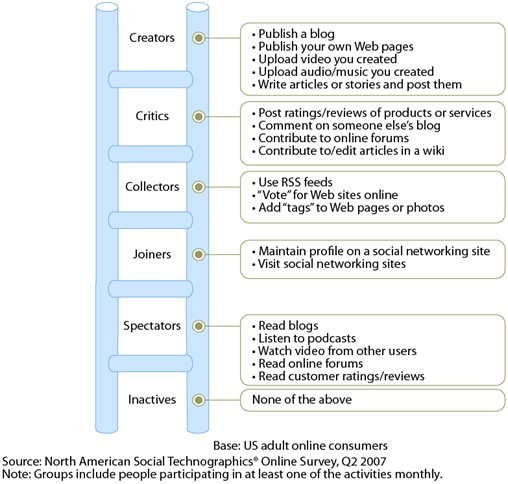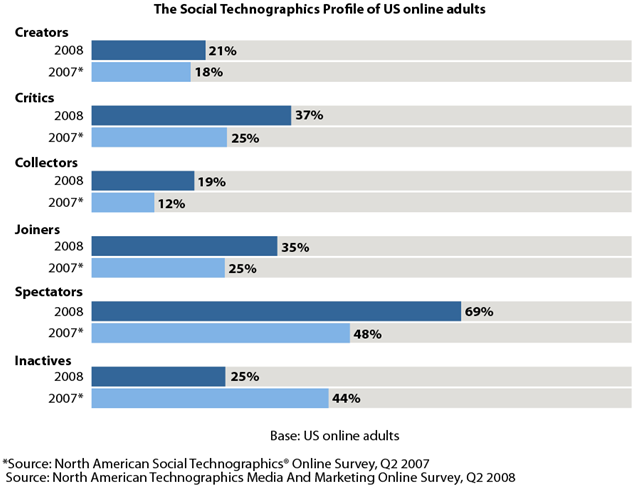Marketing in the Blogosphere
From The Yaffe Center
This page is under construction
Contents |
Acknowledgements
This page is largely adapted from "Joining the Conversation: Marketers, Meet the Blogosphere" written by Elizabeth K B Smith as a student at the University of Michigan Stephen M. Ross School of Business.
What is the Blogosphere?
Although many definitions of (we)blogs exist, the most basic explains that a blog is an online platform that enables one to write without format constriction, word choice, or topic; it can be updated as frequently as wanted and is generally displayed in reverse chronological order (Wikipedia n.d.)
Who is Blogging
25 million bloggers and 104 million blog readers in the US (eMarketer 2008)
"As early adopters, bloggers spend twice as much time online as U.S. adults 18-49, and spend only one-third as much time watching television. While they are online, bloggers are participating in an average of five “Web 2.0” activities such as RSS and Twitter. Bloggers are important to watch, as they are generally the first ones to use new web applications, and are highly influential in speeding adoption." (Technorati 2008)
Although bloggers themselves may be early adopters, their readership (at 50% of the 200 M US online population) is not necessarily as innovative . The popularity of blogs has increased significantly over the past several years, with 346MM people worldwide reading a blog in the past month (about 34% of worldwide internet population) and 184MM reporting that they have started a blog (18% of worldwide internet population). (Technorati 2008) Similarly in the US, eMarketer reports 104MM blog readers (54% of US online population that read once a month) and 25.2 MM (13% of US online population) bloggers in May 2008. (Technorati 2008) Moreover, eMarketer expects readership in the US to reach 145.3MM (64% of US Online population) and the number of bloggers to be 34.7MM (16% of US Online population) by 2012 (see charts below). (eMarketer 2008)
To better understand the discrepancy in blog readership as compared to blog writers, it is important to analyze the behavioral segments across social media. Charlene Li and Josh Bernoff’s “Social Technographics” studies are particularly insightful when reviewing levels of participation in social media and are currently regarded as the most complete framework for reviewing this phenomenon within Web 2.0 literature. (Reviews of Groundswell) The Social Technographics Ladder below illustrates the degrees of activity from participants across social media. Ranging from inactivity (“inactives”) to hyperactivity (“creators”), the largest group (48%) of US online adults are “spectators,” meaning they “consume what others produce.” (Li and Bernoff, Groundswell:Winning in a World Transformed by Social Technologies 2008, 45)
Because they are interacting with a range of brands and products, as opposed to bloggers who may focus their writing on one product category or topic, these critics illustrate a more holistic view of a target consumer across various participation points in the blogosphere. Furthermore, this group has shown considerable growth in participation from 2007-2008, indicating that the fear of participating has dissipated and/or that more sites are providing the infrastructure to facilitate these types of discussions (i.e. comment text boxes, 5-star rating systems, emails directing consumers to review a product they just purchased, etc). Specifically, from 2007-2008, the number of critics posting ratings/reviews grew 69% and those commenting on someone else’s blog grew 34% (see table below). Interestingly, critics have the option of remaining anonymous or posting with a profile that obscures their identity. Whereas maintaining a consistently credible identity is critical to the success of a blog (as discussed later in the paper), anonymity is acceptable for a critic . Thus, the reward value of being a critic is much higher than the perceived risk of participation which begins to explain the significant growth of critic activities as compared to creator activities illustrated below.
Segmentation of Bloggers
"Bloggers are not a homogenous group, but they are an educated and affluent one: three out of four U.S. bloggers are college graduates, and 42% have attended graduate school. They skew male, and more than half have a household income over $75,000." (Technorati 2008)
| Demographics | U.S. Bloggers
(N=550) | European Bloggers
(N=350) | Asian Bloggers
(N=173) |
|---|---|---|---|
| Male | 57% | 73% | 73% |
| Age: 18-34 years old | 42% | 48% | 73% |
| Age: 35+ | 58% | 52% | 27% |
| Single | 26% | 31% | 57% |
| Employed full-time | 56% | 53% | 45% |
| Household income >$75,000 | 51% | 34% | 9% |
| College graduate | 74% | 67% | 69% |
| Average blogging tenure (months) | 35 | 33 | 30 |
| Median Annual Investment | $80 | $15 | $30 |
| Median Annual Revenue | $200 | $200 | $120 |
| % Blogs with advertising | 52% | 50% | 60% |
| Average Monthly Unique Visitors | 18,000 | 24,000 | 26,000 |
Blog Metrics
Traditional media campaigns favor reach and ad response metrics to determine how successful a campaign was. However, the blogosphere incorporates metrics such as: relevance to readers’/bloggers’ lives and/or content of the blog; trust of the company/brand/product; engagement, and the buzz that the campaign generates (i.e. how many other people have talked about it across the blogosphere including Twitter “Tweets”).
Marketers and Blogs
Why Marketers Should Advertise with Blogs
The effect of these reviews and opinions is then magnified through traditional online search: “Bloggers publish their personal recollections of product experiences and service interactions regularly, while search engines index and serve them up, right next to content from publications like Brandweek, community-edited Wikipedia entries, and your meticulously search-optimized corporate Web site.” (Kim, How to Connect with Bloggers 2008)
Blog Sponsorship
Successful Blogosphere Marketing
Marketers should not only be aware of the type of participants in this space, but they should also understand the context in which readers interact with the blogosphere. According to a recent eMarketer report (see chart at right), the majority (48%) of those reading blogs do so for entertainment. That said, marketers should think about the mindset of blog readers when crafting marketing communications. Campaigns should not interrupt readers, but rather should collaborate with them, employing a similar tone to that of the blog. As Seth Godin, a Web 2.0 marketing expert, explains:"Interruption marketing is giving way to a new model that I call permission marketing. The challenge for companies is to persuade consumers to raise their hands - to volunteer their attention. You tell consumers a little something about your company and its products, they tell you a little something about themselves, you tell them a little more, they tell you a little more - and over time, you create a mutually beneficial learning relationship. Permission marketing is marketing without interruptions." (W. C. Taylor 2007)
ROI of Blogging
Practices to Avoid
Bloggers' Trust Issues
Credibility
Transparency
Influence
Even more so than bloggers themselves, critics could potentially turn into the most influential brand advocates across blogs and user-generated reviews. (Li and Bernoff, Groundswell:Winning in a World Transformed by Social Technologies 2008, 43). Because critics comment on blogs, they are an important part of the blog conversation. In fact, critics can be even more influential than bloggers themselves because they react and keep the conversation going. There is a critical difference between critics and bloggers: Whereas maintaining a consistently credible identity is critical to the success of a blog, anonymity is acceptable for critics.
Indeed, with respect to influence, Forrester’s Peter Kim found, “Both adult and youth bloggers are more likely than their peers to tell others about the products that interest them,” both through their blog as well as offline. (Kim, How to Connect with Bloggers 2008)
References
- eMarketer. "Blogs Key for Customer Communication." eMarketer. December 29, 2008. (accessed March 13, 2009).
- Kim, Peter. "How to Connect with Bloggers." July 23, 2008. (accessed January 2009).
- Li, Charlene, and Josh Bernoff. Groundswell:Winning in a World Transformed by Social Technologies. Boston: Harvard Business Press, 2008.
- Reviews of Groundswell can be found here: http://www.forrester.com/Groundswell/reviews.html. Similarly, Li and Bernoff consistently receive reviews of 8 or higher on the Social Technographics articles they have written for Forrester Research. Forrester has implemented their studies across several other authors as well using it as the prevailing framework for assessing participation in social media.
- Taylor, William C. "Permission Marketing." Fast Company. December 18, 2007. http://www.fastcompany.com/magazine/14/permission.html (accessed March 16, 2009).
- Technorati. State of the Blogosphere 2008. December 2008. http://technorati.com/blogging/state-of-the-blogosphere/ (accessed January 2009).







